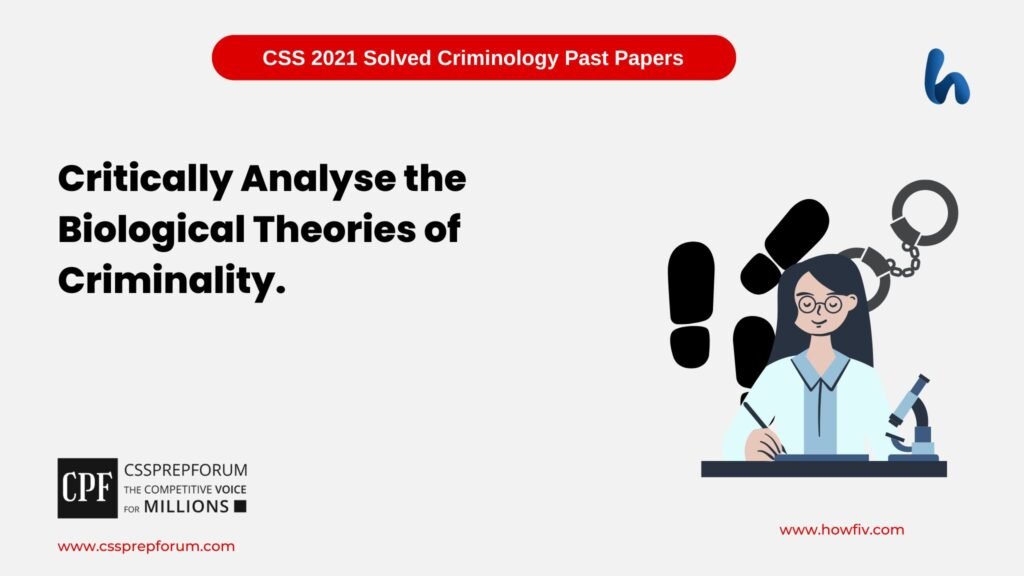CSS Solved Criminology Past Paper CSS 2021 | The Biological Theories of Criminality

Question Breakdown
In this question, the examiner has inquired about the biological theories of criminality. This query can be answered by critically analysing the biological perspectives of criminality. Aspirants should start their answer by defining criminality and criminology. Then, they can explain the various biological perspectives of criminality. Nonetheless, the answer should be critical in nature as the question demands critical analysis of biological theories. The addition of scholarly references, definitions, and examples will make the answer outstanding. Moreover, flowcharts, diagrams, tables, and relevant quotations can further enhance the quality of the answer.
Outline
1-Introduction
2-Defining Criminality
3-Biological Theories of Criminality
- ✓Degeneration Theory
- ✓Biological Positivism
- ✓Physiognomy
- ✓Phrenology
- ✓Body Type Theory
- ✓Two-Path Theory
- ✓Neurological Theories of Crime
- ✓Genetic Explanations of Crime
4-Critical Analysis
5-Conclusion

Answer to the Question
Introduction
To study and analyse the causes of criminal behaviour, scholars from the pre-classical, classical, biological, psychological, and sociological schools of criminology have been working for a long time. Biological theories of criminology explain that criminal behaviour might be inherited and physiologically determined. According to this perspective, the physical characteristics and genetic makeup of individuals often predispose them to deviant behaviour. Contrary to the classical perspective that delineates the rationality of humans and their free will in the commission of crime, biological theories emphasise the innate factors that influence criminality. Substantial evolution in the biological perspectives of criminality has been envisioned since the pioneering work by Cesare Lombroso. In the contemporary era, the findings of neuroscience, behavioural genetics, and hormonal research are also incorporated into the biological perspective to comprehend the causes of criminality. A. Raine, in The Anatomy of Violence 2013, puts forth,
“There is no gene for crime, but there are genetic susceptibilities that, combined with environmental factors, can increase the risk.”
Defining Criminality
Criminality refers to the behaviour of individuals that is either against criminal law or forbidden by it. In his work titled “Principles of Criminology”, Edwin H. Sutherland defines criminality as,
“The behaviour that violates the criminal law and is subject to penalties by the state.”
According to Larry J. Siegel,
“Criminality refers to a behavioural predisposition that disproportionately favours the commission of criminal acts.”
In other words, criminality refers to certain characteristics in individuals that lead to a continuous willingness to violate criminal law, practice anti-social behaviour and deviate from social norms.
Biological Theories of Criminality
The biological perspective is also known as the positive school of criminology, which rejects the propositions of the classical perspective because it failed to discuss the physical attributes of criminals. It gives the biological explanation of crime because Biology is the first science to deal with Homo sapiens.
Degeneration Theory
In 1857, an offshoot of biological perspectives of crime known as Degeneracy Theory put forth that people belonging to lower social strata and races suffer from mental illness genetically, which makes them more prone to criminal behaviour. In his book titled “Traits des Dégénérescences Physiques, Intellectuelles et Morales de l’Espèce Humaine”, B. A. Morel introduced the theory of progressive degeneracy in which he delineated that use of narcotics for instance, hashish, opium and alcohol leads to deterioration of moral and physical health of individuals which passes on from one generation to the other. These individuals, who possess weak morals and exhibit intellectual and physical characteristics, often engage in criminal activities.
Biological Positivism
Cesare Lombroso gave a biological and psychological explanation of crime. In his book titled “The Criminal Man” that was published in 1876, Lombroso gave the concept of Criminal Anthropology and introduced the term “Atavism”. He was of the notion that criminals can be distinguished from the law-abiding citizens on the basis of physical characteristics, also known as anomalies. He also gave the typology of criminals, such as insane criminals and born criminals. Cesare Lombroso said,
“The criminal man is a primitive being who reproduces in his person the ferocious instincts of primitive humanity and the inferior animals.”
Physiognomy
J. K. Lavater was a biological theorist of criminology who studied the index of mind. He developed a relation of facial features with crime and his theory was called physiognomy.
Phrenology
The shape of the skull was studied by Johan K. Franz Gall and Spurzheim. In their theory known as phrenology, they studied the relation of the shape of one’s skull with crime. Furthermore, phrenology is about the study of bumps on one’s head. According to this theory, individuals with bumps on their head and abnormal skull shapes are more likely to engage in criminal activities.
Body Type Theory
William Sheldon was a disciple of Lombroso, who stated in 1940 that the body, rather than the mind, generates crime. According to his theory of Somatotyping, body types are related to one’s behavior and temperament. Sheldon delineated that while endomorphs are people with soft and round body types who are relaxed and amicable, ectomorphs are thin and introverted people who remain reserved. On the other hand, mesomorphs are muscular and active individuals who are assertive and more prone to criminal activities and aggression. In his work titled “The Varieties of Human Physique”, W. Sheldon explained,
“Delinquency was significantly higher among mesomorphs due to their inherent aggressiveness and impulsivity.”
Two-Path Theory
In 1993, Terrie Moffit proposed the Two-Path theory, which is a biosocial perspective on criminality. Moffit classified criminals into two groups: life-course-persistent offenders and adolescent-limited offenders.
The life-course-persistent offenders are anti-social individuals who adopt criminal behaviour in childhood, and it worsens after their adolescence. These criminals are rare, however, and pathological in nature. On the other hand, adolescent-limited offenders are those individuals who practice anti-social behaviour on a temporary basis during adolescence; however, their criminal behaviour ends in young adulthood.
Neurological Theories of Crime
The neural explanations of crime are modern biological theories of criminality. Scholars like Moffit, Ishikawa, and Raine have accentuated the significance of the frontal lobe in influencing criminal behaviour, as this region is responsible for abstract thinking, planning, goal formation, self-monitoring, and concentration, among other functions. Neurological theories focus on the structure and function of the central nervous system in individuals. Through the study of forty-one violent murderers, Raine and other scholars found that there is less activity in the prefrontal cortex and limbic system of offenders. Moreover, individuals with psychological disorders lack emotional intelligence and empathy for others, which can lead to criminal behaviour.
Genetic Explanations of Crime
According to this perspective on criminality, genetic factors influence people to engage in criminal behaviour because genes code for biological factors, such as the functioning of the nervous system and neurochemistry. In order to understand the influence of genetics and environment on individual behavior, Rhee and Waldman carried out a review of twin and adoption studies in which researchers deduced that about 32% of the variation in antisocial behavior is due to additive genetic effects, 9% due to non-additive genetic effects, 16% due to environmental influences shared by the twins, and 43% due to unique environmental influences not shared by the twins. Furthermore, when individuals inherit a predisposition to criminality from their genetics, they are more likely to engage in criminal activities when exposed to such environments. On the other hand, individuals without a genetic predisposition towards criminal behaviour are not prone to engaging in criminal activities, even if exposed to criminal environments.
Critical Analysis
Theorists of the biological perspective on criminality classified criminals into various categories. For instance, Lombroso highlighted that born criminals, insane criminals and occasional criminals are various types of criminals. On the other hand, Enrico Ferri mentioned five types of criminals in 1875, including: insane criminals, criminals by passion, born criminals, habitual criminals and occasional criminals. These types of criminals help in understanding the causes of crime. Similarly, the biological perspective in criminology also helps in understanding the biological and physiological factors that contribute to criminal behaviour. For example, the facial features and shape of the skull indicate that individuals are prone to criminality. Also, when individuals are undergoing a certain illness or their blood pressure is unstable, they might engage in criminal activities. Nonetheless, according to the Psychological Theories of Criminality, people with psychological disorders such as bipolar disorder or schizophrenia are prone to criminal activities. Moreover, the sociological perspective on criminality suggests that criminal behaviour is learned through interaction. Edwin Sutherland puts forth in the Social Learning Theory that deviant behaviour is learnt from the environment in which one lives. Despite biological reasons, there are several other causes of criminality, such as psychological disorders, free will and rationality, as well as the upbringing of individuals.
“Biology may load the gun, but the environment pulls the trigger.”
Conclusion
Cutting to the chase, the biological perspective on criminality suggests that offenders adopt criminal behaviour due to various biological and natural factors. They carry these issues by birth, which influence their behaviour. For example, if a person has six fingers instead of five, research indicates that they are more prone to criminal behaviour and might take a greater interest in it compared to a person with a normal number of fingers. Similarly, criminologists and theorists like William Sheldon, Rafaele Garafalo, and Johann K. Gall have explained that people with physical anomalies, muscular bodies, and abnormal skull shapes, often with bumps on the head, are likely to commit crimes. According to the term “Atavism,” introduced by Cesare Lombroso, law-abiding citizens and people who adopt behaviour contrary to the criminal law can be differentiated on the basis of their physical features. Besides, in 2022, a report by the American Psychological Association unveiled that people with neurodevelopmental disorders are three times more vulnerable to criminal behaviour. Adrian Raine explains,
“Deficits in the prefrontal cortex are associated with poor behavioural inhibition and increased criminal risk.”

CSS Solved Past Papers’ Essays
Looking for the last ten years of CSS and PMS Solved Essays and want to know how Sir Kazim’s students write and score the highest marks in the essays’ papers? Then, click on the CSS Solved Essays to start reading them.
CSS Solved Essays
CSS Solved General Science & Ability Past Papers
Want to read the last ten years’ General Science & Ability Solved Past Papers to learn how to attempt them and to score high? Let’s click on the link below to read them all freely. All past papers have been solved by Miss Iqra Ali & Sir Ammar Hashmi, Pakistan’s top CSS GSA coach having the highest score of their students.












